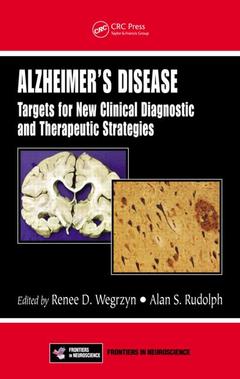Description
Alzheimer's Disease
Targets for New Clinical Diagnostic and Therapeutic Strategies
Frontiers in Neuroscience Series
Coordinators: Wegrzyn Renee D., Rudolph Alan S.
Language: English
Subjects for Alzheimer's Disease:
Keywords
Amyloid Plaques; BACE1; Alzheimer’s; ADNI; Neurodegenerative disease; BACE1 Inhibitor; In vivo diagnostics; Senile Plaques; In vitro diagnostics; Ad Field; Immunotherapy; Amyloid Pet Imaging; amyloid; Repetitive Mild TBI; Traumatic Brain Injury; Aβ Assembly; Alzheimer’s Disease; Mild TBI; Severe TBI; Familial Ad; Aβ Oligomers; Prion Protein; PrP; Brain Injury; AlzGene Database; Amyloid Imaging Agents; Brain Trauma; Aβ Levels; TBI Patient; Target Aβ; Ad Patient
312 p. · 15.6x23.4 cm · Hardback
Description
/li>Contents
/li>Readership
/li>Biography
/li>
In recent years, a tremendous amount of effort has been focused on better understanding the fundamentals of Alzheimer?s disease (AD) to facilitate early and accurate diagnosis and appropriately targeted therapeutic treatments. Alzheimer?s Disease: Targets for New Clinical, Diagnostic, and Therapeutic Strategies provides a detailed synopsis of the current state of the art of diagnostics and therapeutics and identifies emerging technologies and molecules that show promise in the management and treatment of AD.
With contributions from experts drawn from academia, clinical practice, and the biotechnology and pharmaceutical industries, the book explores:
- The basis of AD and the role of A? oligomers in development of disease
- Existing and emerging in vitro biomarker-based methodologies for the diagnosis of AD, focusing on genetic, biochemical, and conformational strategies
- In vivo imaging diagnostic approaches
- Evolving diagnostic criteria, health regulatory guidelines, biomarkers in clinical trials, and available and emerging therapies
- Recent progress in small-molecule disease-modifier drug discovery efforts for AD, specifically in the areas of A?, tau, and emerging neuroprotective/neurorepair approaches
- How a case study of AD raises issues regarding clinical and pathologic criteria, risk factors, and the amyloid hypothesis
- The molecular conformational factors that govern the pathogenicity of aggregating proteins, and how these factors could represent new targets for disease-modifying therapies
- The latest epidemiological, pathological, biochemical, and behavioral studies that may shed some light on the risk of developing AD and similar dementias after traumatic brain injury
Examining current hypotheses and suggesting possible new approaches to therapeutic clinical applications, this volume paves the way for a robust pipeline of therapeutics to combat not only AD, but a whole host of other neurodegenerative diseases.
The Amyloid β-Protein and Alzheimer’s Disease. Emerging Principles and Biomarkers in In Vitro Diagnostics for Alzheimer’s Disease. Imaging Biomarkers for Diagnosis, Prognosis, and Treatment of Alzheimer’s Disease. The Current Status of Alzheimer’s Disease Treatment: Why We Need Better Therapies and How We Will Develop Them. New Small Molecule Drug Discovery for Alzheimer’s Disease. Alzheimer’s Disease: Clinical Aspects. Pathogenic Protein Strains as Diagnostic and Therapeutic Targets in Alzheimer’s Disease. Traumatic Brain Injury in the Development of Alzheimer’s Disease: Risk Factors, Diagnosis, and Treatment Strategies.
Renee D. Wegrzyn obtained her PhD in applied biology from the Georgia Institute of Technology where she studied the propagation of prion proteins in model systems. Dr. Wegrzyn was awarded an Alexander von Humboldt Research Fellowship for her postdoctoral studies to investigate de novo protein folding at the ribosome. She applied her expertise in protein folding to the challenge of developing in vitro diagnostics for neurodegenerative diseases—including Alzheimer’s and prion diseases—as a group leader at Adlyfe, Inc. She is currently a scientific and technical consultant for the Department of Defense.
Alan S. Rudolph




